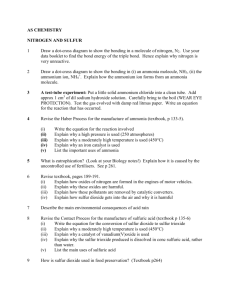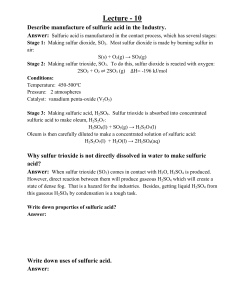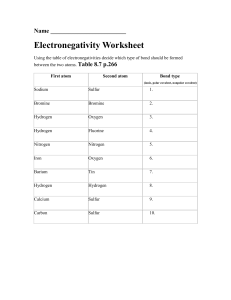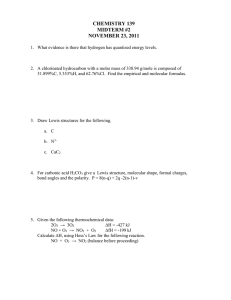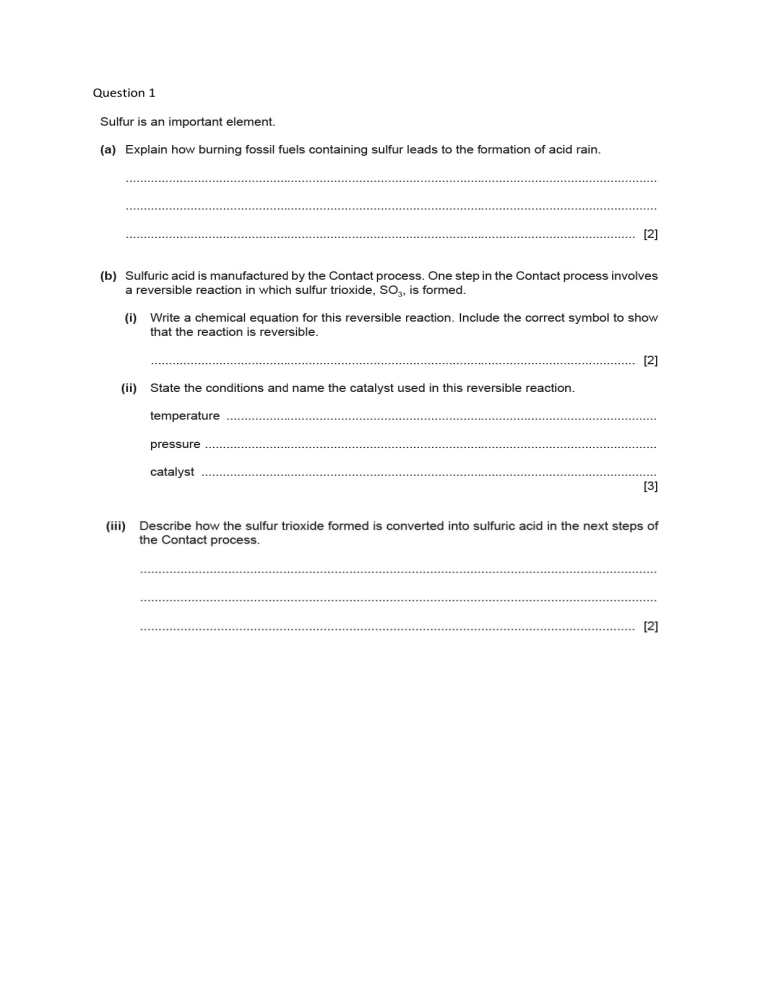
Question 1 Question 2 13 7 Ammonia is made by the Haber process. N2(g) + 3H2(g) 2NH3(g) (a) State one major use of ammonia. ..................................................................................................................................... [1] (b) Describe how hydrogen is obtained for the Haber process. ........................................................................................................................................... ........................................................................................................................................... ..................................................................................................................................... [3] (c) This reaction is carried out at a high pressure, 200 atmospheres. State, with an explanation for each, two advantages of using a high pressure. ........................................................................................................................................... ........................................................................................................................................... ........................................................................................................................................... ........................................................................................................................................... ..................................................................................................................................... [5] (d) (i) What is the difference between an endothermic and an exothermic reaction? .................................................................................................................................... .............................................................................................................................. [1] C S 2012 0620/33/O/N/12 [Turn over 14 (ii) Bond breaking is an endothermic process. Bond energy is the amount of energy needed to break or form one mole of the bond. Complete the table and explain why the forward reaction is exothermic. bond bond energy kJ / mol energy change kJ exothermic or endothermic +944 endothermic N N 944 H H 436 N H 388 3 436 = +1308 ........................................................................................................................................... ..................................................................................................................................... [3] [Total: 13] C S 2012 0620/33/O/N/12 7 5 Ammonia is made by the Haber process. N2(g) + 3H2(g) 2NH3(g) The forward reaction is exothermic. The conditions in the reaction chamber are: a pressure of 200 atmospheres, a catalyst of finely divided iron, a temperature of 400 to 450 C. (a) What are the two advantages of using a high pressure? Give a reason for both. advantage 1 ............................................................................................................................... reason ........................................................................................................................................ .................................................................................................................................................... advantage 2 ............................................................................................................................... reason ........................................................................................................................................ .................................................................................................................................................... [4] (b) A higher temperature would give a faster reaction rate. Why is a higher temperature not used? .................................................................................................................................................... .................................................................................................................................................... .............................................................................................................................................. [3] (c) (i) Why is the iron catalyst used as a ne powder? ............................................................................................................................................. ....................................................................................................................................... [1] (ii) Give two reasons why a catalyst is used. ............................................................................................................................................. ............................................................................................................................................. ............................................................................................................................................. ....................................................................................................................................... [2] C S 2014 0620/33/M/J/14 [Turn over 8 (d) The equilibrium mixture leaving the reaction chamber contains 15% ammonia. Suggest how the ammonia could be separated from the mixture. boiling point / C hydrogen 253 nitrogen 196 ammonia 33 .................................................................................................................................................... .............................................................................................................................................. [2] (e) Ammonia is used to make nitrogen tri uoride, NF3. Nitrogen tri uoride is essential to the electronics industry. It is made by the following reaction. Determine if the above reaction is exothermic or endothermic using the following bond energies and by completing the following table. The rst line has been done as an example. Bond energy is the amount of energy, in kJ / mole, needed to break or make one mole of the bond. bond bond energy in kJ / mole N H 390 F F 155 N F 280 H F 565 bond energy change / kJ N H (3 390) = 1170 F F N F H F .................................................................................................................................................... .............................................................................................................................................. [4] [Total: 16] C S 2014 0620/33/M/J/14 8 5 Sulfuric acid can be manufactured from the raw materials sulfur, air and water. The process can be divided into four stages. stage 1 converting sulfur into sulfur dioxide stage 2 converting sulfur dioxide into sulfur trioxide stage 3 converting sulfur trioxide into oleum, H2S2O7 stage 4 converting oleum into sulfuric acid stage 1 (a) (i) Describe how sulfur is converted into sulfur dioxide. ....................................................................................................................................... [1] (ii) Write a chemical equation for the conversion of sulfur into sulfur dioxide. ....................................................................................................................................... [1] stage 2 (b) Sulfur dioxide is converted into sulfur trioxide according to the following equation. 2SO2 + O2 2SO3 The reaction is carried out at a temperature of 450 C and a pressure of 1–2 atmospheres H, for the reaction is –196 kJ / mol. (i) What is the meaning of the symbol ? ....................................................................................................................................... [1] (ii) Name the catalyst used in this reaction. ....................................................................................................................................... [1] (iii) Why is a catalyst used? ....................................................................................................................................... [1] (iv) If a temperature higher than 450 C were used, what would happen to the amount of sulfur trioxide produced? Give a reason for your answer. ............................................................................................................................................. ....................................................................................................................................... [2] (v) Suggest a reason why a temperature lower than 450 C is not used. ............................................................................................................................................. ....................................................................................................................................... [1] © UCLES 2016 0620/43/O/N/16 9 (vi) If a pressure higher than 1–2 atmospheres were used, what would happen to the amount of sulfur trioxide produced? Give a reason for your answer. ............................................................................................................................................. ....................................................................................................................................... [2] stage 3 (c) (i) What is added to sulfur trioxide to convert it into oleum? ....................................................................................................................................... [1] (ii) Write a chemical equation for the conversion of sulfur trioxide into oleum. ....................................................................................................................................... [1] stage 4 (d) (i) What is added to oleum to convert it into sulfuric acid? ....................................................................................................................................... [1] (ii) Write a chemical equation for the conversion of oleum into sulfuric acid. ....................................................................................................................................... [1] (e) Give one use of sulfuric acid. .............................................................................................................................................. [1] (f) Sulfuric acid reacts with a hydrocarbon called benzene to produce benzenesulfonic acid, C6H5SO3H. Benzenesulfonic acid is a strong acid which ionises to produce hydrogen ions, H+, and benzenesulfonate ions, C6H5SO3–. (i) What is meant by the term strong acid? ....................................................................................................................................... [1] (ii) Describe how to show that a 1 mol / dm3 solution of benzenesulfonic acid is a strong acid. ............................................................................................................................................. ....................................................................................................................................... [2] (iii) Write a chemical equation for the reaction between benzenesulfonic acid and sodium carbonate, Na2CO3. ....................................................................................................................................... [2] [Total: 20] © UCLES 2016 0620/43/O/N/16 [Turn over
